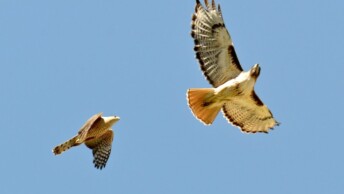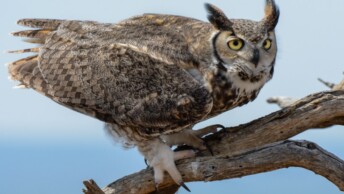Gulls are among the most widespread and recognizable seabirds of North America. Belonging to the subfamily Larinae of the family Laridae, they range from small, delicate species like Bonaparte’s gull to massive, heavy-bodied birds such as the great black-backed gull. These opportunistic feeders are found in nearly every coastal and inland habitat, from Arctic cliffs and prairie wetlands to city parks and landfills.
This guide introduces the gull species most regularly seen in the United States and Canada, highlighting their identification, habits, and habitats. It includes the familiar and abundant species as well as regional specialists and rare visitors that add to the diversity of this group.
American Herring Gull
Larus smithsonianus
- Identification: Large pale-backed gull with black wingtips and white “mirrors,” yellow bill with red spot, pale eye, and pink legs; heavy, long-winged build.
- Where found: Breeds widely from western Alaska across boreal and Arctic Canada to Newfoundland and south to the Great Lakes and Atlantic coast; winters along both coasts, the Gulf, the Great Lakes, and major inland rivers.
- How to spot: Look for a big, pale-gray mantled gull with pink legs and a pale eye; immatures progress from dark brown to mottled gray before adult plumage; often around fishing boats, dumps, and large lakes.
- Conservation status: Least Concern globally; long-term North American decline with mixed local trends and human-related pressures.
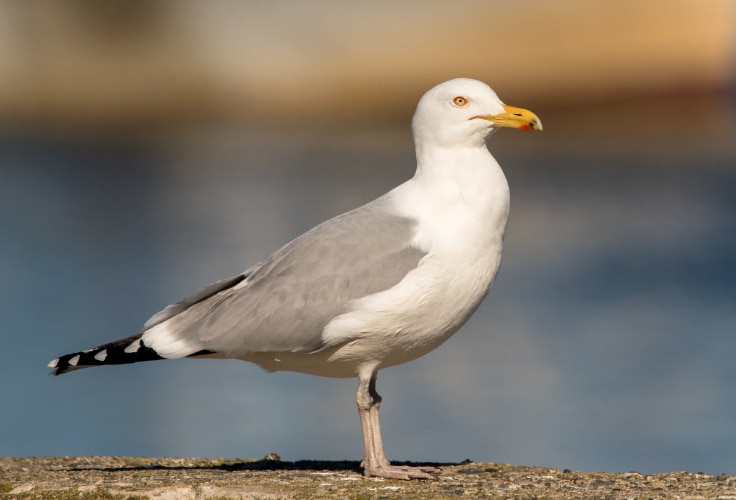
The American herring gull is the standard large gull across much of North America and serves as a key reference for identifying other white-headed gulls. Adults measure 53 to 66 centimeters (20.9 to 26.0 inches) in length and show a robust body, broad wings, and a strong, deep bill. Males average larger with noticeably heavier bills than females.
Breeding adults are clean white on head, neck, body, and tail, with a pale gray back and upperwings, black wingtips marked by white spots (“mirrors”), a yellow bill with a red subterminal spot, pale golden eye with a yellow to orange orbital ring, and pink legs. In non-breeding plumage the head and neck become variably streaked gray-brown and bare parts dull slightly. Juveniles are mostly brown, gradually becoming paler with more gray on the back and white underneath as they age. Adult plumage is usually reached by the fourth year.

In the field, expect long periods of level gliding and soaring with steady, unhurried wingbeats, often low over water or high when commuting. The species is raucous and assertive at food sources, frequently stealing from other birds and dropping shellfish onto hard surfaces to break them. Calls are varied; as in Eurasian relatives, a classic long, laughing series and shorter mew-like notes carry around colonies and loafing sites. Diet is broad and opportunistic – fish, mollusks, crustaceans, invertebrates, carrion, bird eggs and young, augmented by refuse and fishery discards; birds specialize locally on predictable foods and often follow boats or gather at landfills.
Breeding spans northern North America from interior Alaska across Canada to Labrador and Newfoundland, extending south through the Great Lakes and along the Atlantic coast to North Carolina. Inland breeders favor the boreal zone but also nest widely on lakes and islands. Nests are placed on the ground in open, treeless settings – cliffs, rocky or grassy islands, beaches, gravel bars, saltmarsh edges, even rooftops, with a preference for sites sheltered from prevailing winds and near an object such as a rock or shrub that screens neighbors. Wintering birds occur along the Pacific from British Columbia to northwestern Mexico, around the Gulf of Mexico, and along the Atlantic from Newfoundland to Florida, as well as on the Great Lakes and along major river valleys.
Abundance is high in many regions, but long-term monitoring indicates substantial declines in North America, with mixed local trends. Historical persecution and egging collapsed numbers in the late 19th century, followed by rebounds linked to legal protection and new food sources from fisheries and landfills. Recent decades bring renewed pressures from changing fish communities, reduced fishery waste, pollutants, and targeted control near airports or colonies. Adaptive management of waste streams, fisheries bycatch, and colony protection remain important for maintaining stable regional populations.
Ring-Billed Gull
Larus delawarensis
- Identification: Medium-sized gull with a yellow bill marked by a bold black ring, pale eye, and yellow legs; adults have gray backs, white head and body, and black wingtips with white spots.
- Where found: Breeds across southern Canada and the northern United States; winters widely across the U.S., Mexico, and Caribbean coasts, more common inland than most gulls.
- How to spot: Look for the black ring on the bill and yellow legs; in flight shows slender wings and quick, buoyant flight; often seen in flocks at lakes, rivers, fields, and parking lots.
- Conservation status: Least Concern globally; populations recovered strongly in the 20th century and are now abundant, though vulnerable to pollutants and sometimes controlled as pests.
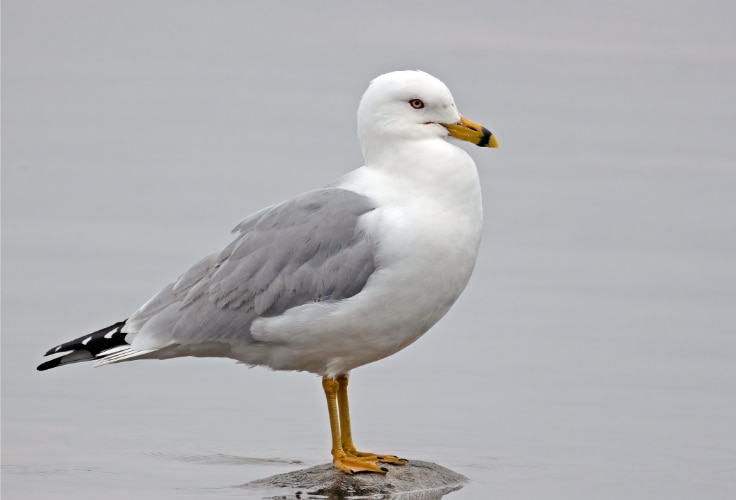
The ring-billed gull is one of the most familiar gulls in inland North America, often encountered far from the coast at lakes, rivers, fields, and even parking lots. Adults measure 43 to 54 centimeters (16.9 to 21.3 inches) in length and show a medium build, long slender wings, and a relatively short, slim bill. This species is smaller and lighter than the herring gull but larger and more robust than the short-billed gull.
Adults in breeding plumage are crisp gray above and white below, with black wingtips marked by small white spots (“mirrors”), a pale eye, yellow legs, and a yellow bill crossed by a distinctive black ring. Non-breeding adults show brownish streaking on the head. Juveniles are mottled brown and gray overall with a pinkish bill tipped in black, gradually becoming paler as they approach adult plumage by their third year. Males and females look alike, with males averaging slightly larger.
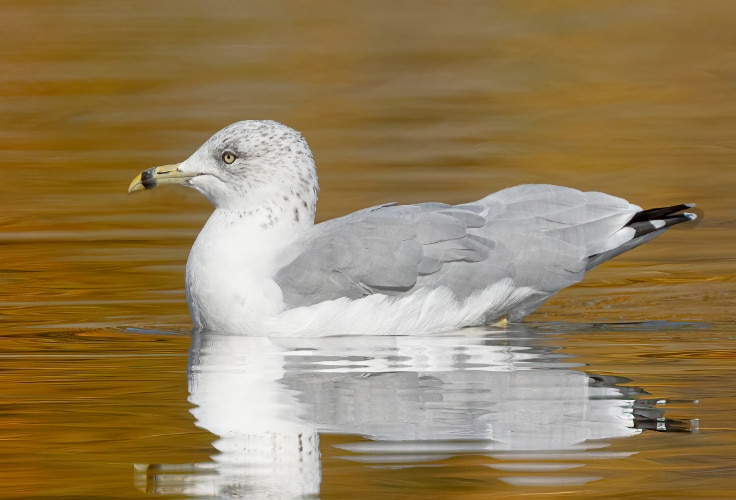
In the field, ring-billed gulls are graceful flyers, beating slender wings with a light, buoyant rhythm. They hover, soar, or even hang motionless in the wind, and are adept at snatching food in midair. Their calls are varied and often harsh, including a distinctive long, rolling “kreeee-aaaah.” Opportunistic foragers, they pick insects, fish, and invertebrates from water or fields, stamp their feet to stir prey, hunt rodents, scavenge at landfills, and frequently steal from other birds. They are highly social and often gather in large flocks, especially around human food sources.
Breeding colonies occur across southern Canada, the northern United States, and locally farther west, usually near freshwater lakes and rivers. Nesting is mostly on low islands or peninsulas with sparse vegetation, though colonies also occur on the Great Lakes’ shorelines and occasionally near coasts. Colonies can range from dozens to tens of thousands of pairs. Winter distribution extends across the southern United States, Mexico, the Gulf of Mexico, and Caribbean coasts, with large numbers along both Atlantic and Pacific seaboards as well as at major inland lakes and rivers.
Once driven to near-extirpation by hunting for the feather trade and loss of nesting sites, ring-billed gulls rebounded strongly in the 20th century after protective legislation. Populations grew rapidly with the availability of garbage dumps, agricultural fields, and fishery waste, and today the species is widespread and abundant, sometimes to the point of being considered a nuisance around cities and airports. Pollution by pesticides and industrial chemicals historically harmed some populations, but regulatory changes reduced these threats.
Bonaparte’s Gull
Chroicocephalus philadelphia
- Identification: Small, graceful gull with a black hood in breeding plumage, white wedge on the leading wing edge, black-tipped outer primaries, fine black bill, and reddish legs.
- Where found: Breeds across boreal forests of Alaska and Canada near lakes and wetlands; winters widely along coasts, bays, and large lakes from southern Canada to Mexico, including both Atlantic and Pacific coasts.
- How to spot: Look for its small size, buoyant fluttering flight, and white wedge on the wing; often forages in tight flocks, dipping delicately to snatch prey from the surface.
- Conservation status: Least Concern globally; numbers stable or increasing, though vulnerable to toxins and climate-driven prey shifts.
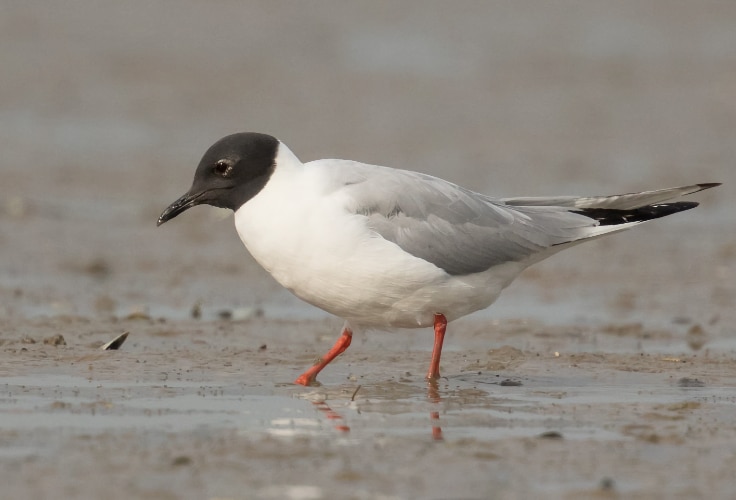
The Bonaparte’s gull is the most widespread small gull in North America and the only gull on the continent that regularly nests in trees. Adults measure 28 to 38 centimeters (11.0 to 15.0 inches) in length, noticeably smaller and daintier than ring-billed or herring gulls. Its light build, pointed wings, and quick movements make it one of the most tern-like of the gulls.
In breeding plumage, adults show a neat black hood with narrow white eye crescents, a pale gray mantle, clean white underparts, and black-tipped wings that display a striking white wedge in flight. The bill is fine and black, and the legs are orange-red. In non-breeding plumage the head turns white with a dark ear spot, and the legs become pinkish. Juveniles and first-winter birds are mottled with brown and black on the wings, with a dark tail band and pale pinkish legs, before gradually acquiring the adult’s crisp appearance.

Field identification is aided by its buoyant, fluttering flight and tendency to forage in cohesive flocks. Unlike heavier gulls, Bonaparte’s gulls dip and pick delicately from the water surface, hover and snatch insects in midair, or spin on the water like phalaropes. They also forage in farm fields for invertebrates, and on lakes and coastal waters they often use “conveyor belt” flock-feeding, flying into the wind and dipping in sequence over concentrated prey. Their calls are high-pitched and tern-like, usually softer than the harsh cries of larger gulls.
Breeding occurs across Alaska, Yukon, and much of boreal Canada south to British Columbia, the Prairie Provinces, Ontario, and Quebec. Most nests are placed in conifer trees near lakes, ponds, or muskeg wetlands, an unusual habit among gulls. After the breeding season, large flocks gather to migrate south, concentrating on the Great Lakes, major rivers, and coastal bays. Wintering occurs widely along both coasts from southern Canada to Florida, the Gulf of Mexico, Baja California, and interior lakes where water remains open.
Populations of Bonaparte’s gull are stable or increasing and the species remains common across its range. Past declines linked to hunting and disturbance have been reversed, and today it is secure, though still exposed to environmental threats such as pollution, toxins, and shifts in fish and insect populations under climate change. Its adaptability to both natural wetlands and human-modified environments has helped ensure its continued abundance.
California Gull
Larus californicus
- Identification: Medium-sized gull with medium-gray back, dark eye, yellow-green legs, and a yellow bill marked with both red and black spots.
- Where found: Breeds in colonies across interior lakes of the western United States and Canada; winters along the Pacific Coast from British Columbia to Mexico and inland valleys.
- How to spot: Look for the combination of dark eye, yellow-green legs, and bill with red and black markings; often seen in large colonies inland or flocks along coasts and lakes.
- Conservation status: Least Concern globally; populations stable overall though local declines linked to drought and habitat change, balanced by growth at San Francisco Bay salt ponds.

The California gull is a hallmark of the western interior, especially famous at its Great Salt Lake colonies where it is the state bird of Utah. Adults measure 46 to 55 centimeters (18.1 to 21.7 inches) in length, making them larger than ring-billed gulls but smaller and slimmer-billed than herring gulls. Their medium build and long wings give them a more elegant look than bulkier white-headed gulls.
Breeding adults are crisp white-headed gulls with a medium-gray back, yellow-green legs, and a dark eye that contrasts with the pale plumage. Their yellow bill shows both a black ring and a red spot on the lower mandible, a distinctive combination. Non-breeding adults have brown streaking on the head and duller bare parts. Juveniles are mottled brown with a pink bill tipped in black and pinkish legs, gradually turning gray-backed in the second year and nearly adult-like by the fourth year.

In the field, California gulls are highly adaptable foragers. They follow plows across fields for insects, chase dense clouds of alkali flies at saline lakes, and pick brine shrimp from the water’s surface. On coasts and reservoirs they scavenge, dive shallowly for fish, and steal from other birds. Agile and buoyant in flight, they can hover, soar, or run swiftly on land while snapping at prey. Social by nature, they often form large mixed flocks outside the breeding season and are noisy, with harsh calls and long wails typical of gulls.
Breeding is centered in colonies on islands in lakes and reservoirs across the Great Basin, Intermountain West, and northern Great Plains, from Mono Lake in California and the Great Salt Lake in Utah north to Alberta, Manitoba, and the Northwest Territories. Colonies vary dramatically in size, from a few hundred to tens of thousands of pairs, depending on predator access and water levels. Wintering birds shift largely to the Pacific Coast, from British Columbia south to Baja California and the Gulf of California, with large inland concentrations in California’s Central Valley and scattered sites along the lower Colorado River.
The species remains widespread and numerous, though its fortunes vary regionally. Populations at Mono Lake have suffered during droughts when falling water levels exposed islands to mammalian predators, while birds in San Francisco Bay have expanded in newly available salt pond habitat. Overall, California gulls are stable and secure, benefiting from their flexible diet and broad habitat use, yet vulnerable to water management decisions and long-term environmental change in their inland breeding strongholds.
Short-Billed Gull
Larus brachyrhynchus
- Identification: Small, delicate gull with rounded head, dark eye, slender short bill, medium-gray back, and white wing tips with black edges.
- Where found: Breeds across Alaska, Yukon, and western Canada in wetlands, meadows, and coastal areas; winters along the Pacific Coast from southern Alaska to Baja California.
- How to spot: Look for its dainty build, dark eye, and unmarked yellow bill in breeding plumage; flight is buoyant and tern-like, with fluttering dips and turns over water.
- Conservation status: Least Concern globally; listed as a Tipping Point species in North America due to steep long-term declines and vulnerability to oil spills and habitat loss.

The short-billed gull is the smallest of the common white-headed gulls in western North America, often described as “cute” thanks to its rounded head, large dark eye, and fine short bill. Adults measure 41 to 46 centimeters (16.1 to 18.1 inches) in length, giving them a daintier appearance than the more robust ring-billed or california gulls.
Breeding adults are clean white-headed gulls with a medium-gray mantle, yellow-green legs, and a plain yellow bill that may show faint reddish or dusky markings. Wingtips are black with large white spots forming a noticeable patch, and the tertials and scapulars are fringed in white. In winter, adults develop gray-brown mottling on the head and neck. Juveniles are mottled brown with a dark-tipped pinkish bill and dark tail, gradually becoming paler with gray mantles during their second year.
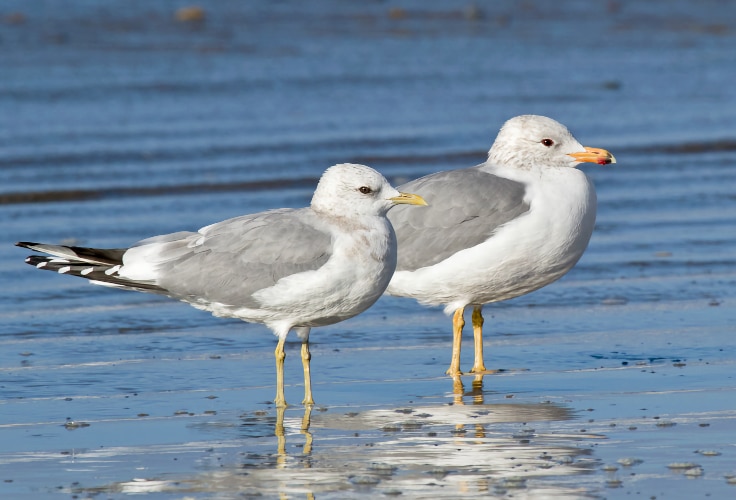
In the field, short-billed gulls show buoyant, fluttering flight and often forage in a manner reminiscent of Bonaparte’s gull, spinning on the water surface or dipping delicately to pick food. They feed opportunistically on fish, insects, and invertebrates, catching prey by dipping, surface-seizing, plunge-diving, or even running through swarms of flies. Their calls are sharper and more squeaky than those of larger gulls. Social by nature, they gather in colonies to breed and in large flocks during migration and winter.
Breeding occurs across Alaska, the Yukon, and western parts of Canada south to British Columbia, northern Alberta, and Saskatchewan, often on islands in lakes, river deltas, and coastal meadows. Nests may be placed on the ground among grasses or on hummocks, and less often in stumps or low shrubs. Colonies can be scattered or dense, with pairs defending small territories. After breeding, adults and fledged young move to rivers, estuaries, and coastlines before heading south for winter. The species winters mainly along the Pacific Coast from southeastern Alaska to central and southern California, with concentrations in the Strait of Georgia, Puget Sound, San Francisco Bay, and Monterey Bay.
Although still numerous, short-billed gulls have undergone significant declines, losing more than half their population in the past 50 years. Threats include oil spills, which contaminate plumage and prey, as well as habitat alteration, pollution, and climate-driven changes to food availability. Once grouped with the Old World common gull (Larus canus), it is now recognized as a distinct North American species of concern, requiring careful monitoring and conservation to secure its future.
Franklin’s Gull
Leucophaeus pipixcan
- Identification: Small gull with medium-gray back, black head in breeding plumage, white eye arcs, large white wingtip spots, and red bill and legs.
- Where found: Breeds in prairie wetlands of central Canada and the northern United States; winters mainly along the Pacific coast of South America from Peru to Chile.
- How to spot: Look for its neat black hood, strong white eye arcs, and buoyant, graceful flight; gathers in vast flocks during migration.
- Conservation status: Least Concern globally; steep long-term declines in North America, driven by wetland loss, disturbance, and environmental pollution.
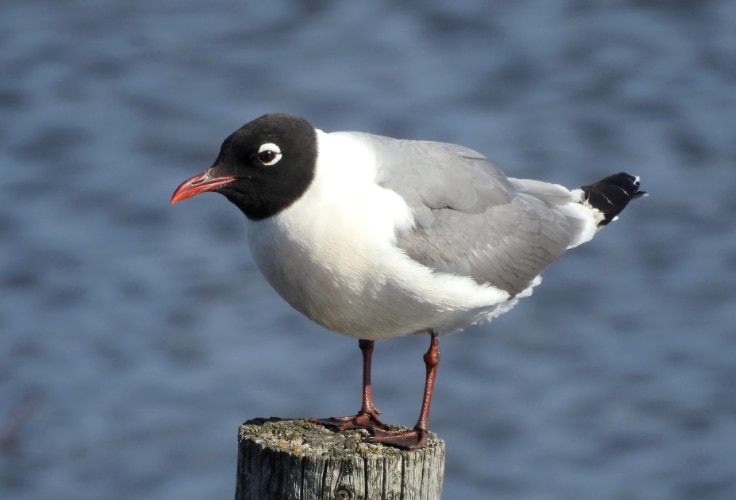
The Franklin’s gull is the only North American gull that migrates regularly south of the equator, wintering along the Pacific coast of South America. Adults measure 32 to 36 centimeters (12.6 to 14.2 inches) in length and are delicate in build, with a rounded head, short tail, and buoyant, tern-like flight. Their long migrations and immense colonial nesting gatherings make them among the most remarkable gulls of the prairies.
In breeding plumage, adults show a full black hood with bold white eye arcs, medium-gray back, white underparts often washed with pale pink, and strikingly large white “mirrors” on the wingtips. The bill and legs are deep red. In non-breeding plumage, the hood recedes to a dusky cap and nape, leaving a white face framed by a dark “saddle.” Juveniles and first-winter birds are mottled brownish-gray with darker wing coverts and a pale tail marked by a dark terminal band.
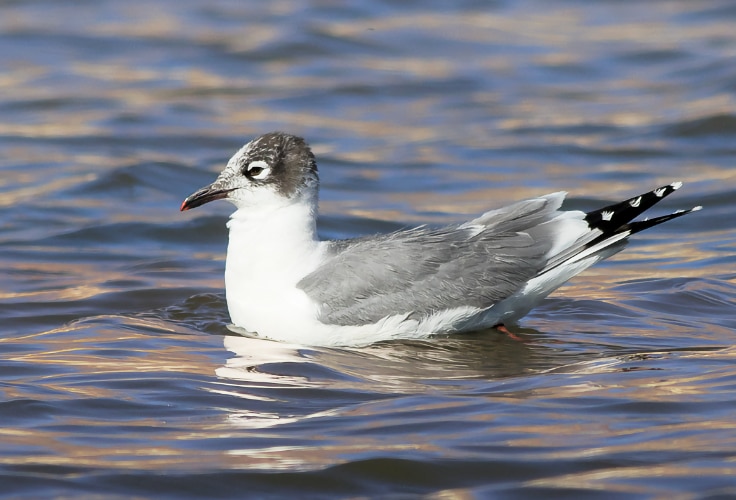
In the field, Franklin’s gull is noted for its buoyant, agile flight and foraging versatility. It often hovers and dips for insects, feeds while swimming in a phalarope-like spinning motion, or follows plows and tractors to snatch exposed invertebrates. Calls are high-pitched and noisy, especially in colonies, where the din can be heard miles away. This species is highly gregarious year-round, forming immense flocks during migration and winter, and frequently roosting or foraging in mixed groups with other gulls, terns, and shorebirds.
The breeding range centers on freshwater marshes of the northern Great Plains and Canadian Prairies, from Alberta and Manitoba south into the Dakotas, Minnesota, Montana, and parts of the Intermountain West. Nests are built on floating mats of vegetation or muskrat lodges within cattails, bulrushes, or other emergent plants. Colonies can number in the tens of thousands and are extremely sensitive to disturbance, often erupting in mass “panic flights” at the first sign of intrusion.
Despite their global abundance, Franklin’s gull populations have declined sharply in North America, losing over half their numbers in the past half-century. Wetland drainage, agricultural conversion, and sensitivity to human disturbance at colonies remain major threats. Additional pressures include contamination from heavy metals and changing hydrological conditions tied to climate change. Conservation of prairie wetlands and protection of large breeding colonies are essential for securing the future of this long-distance migrant.
Laughing Gull
Leucophaeus atricilla
- Identification: Medium-sized gull with a dark gray back, long wings, black hood in breeding plumage, and reddish bill and legs.
- Where found: Breeds locally along the Atlantic and Gulf coasts of North America, through the Caribbean, and parts of Mexico; winters from the southern U.S. southward into northern South America.
- How to spot: Look for its long, slender build, loud laughing calls, and habit of following fishing boats or pelicans to steal food; in flight shows dark primaries with only small white spots.
- Conservation status: Least Concern globally; populations increasing after past declines from hunting, though still vulnerable to habitat loss, disturbance, and pollution.
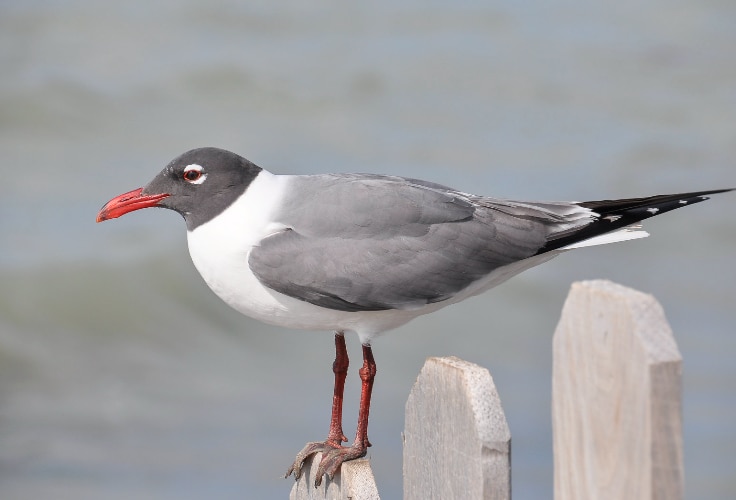
The laughing gull is the most familiar black-hooded gull along the Atlantic and Gulf coasts of North America. Adults measure 39 to 46 centimeters (15.4 to 18.1 inches) in length and appear slim and long-winged compared with the shorter, more compact Franklin’s gull. Their raucous “laughing” calls give the species its name and are a frequent sound along beaches and bays.
In breeding plumage, adults show a solid black hood with narrow white eye crescents, a dark gray mantle, white underparts, and black wingtips with only small white spots. The bill and legs are reddish, often brightest in the breeding season. In non-breeding plumage the hood recedes to dusky smudges on a mostly white head, with the bill and legs turning darker. Juveniles are brown with a scaly pattern on the back and a dark tail band, maturing through mottled intermediate plumages before attaining adult appearance.
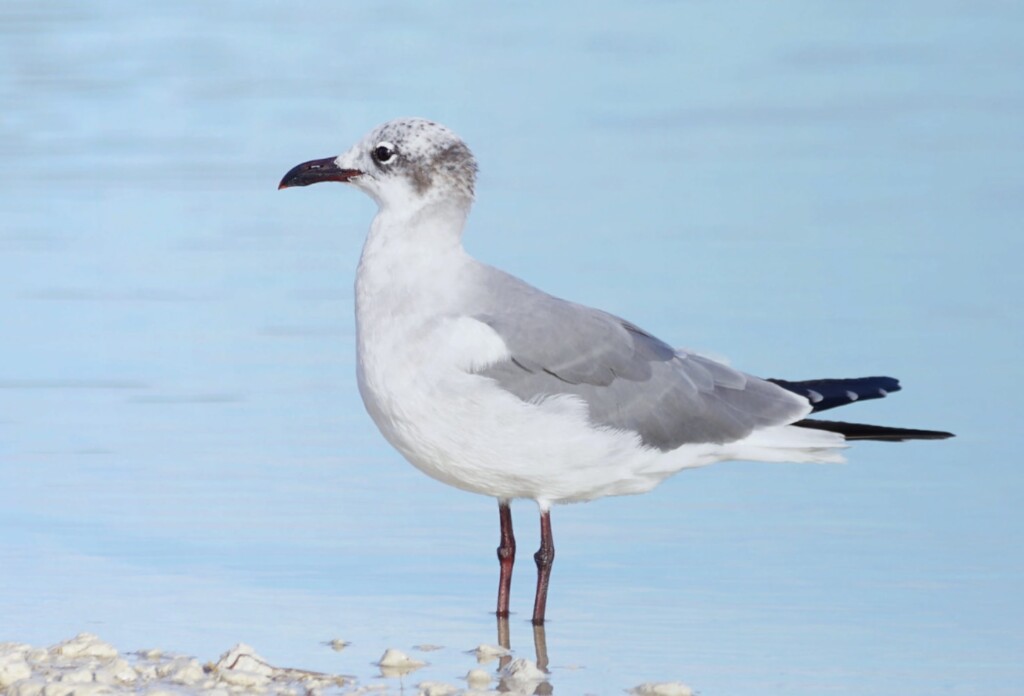
These gulls are opportunistic feeders with a wide repertoire of behaviors. They forage by walking along shorelines, dipping delicately from the surface while swimming, or plunge-diving for fish. They are also notorious kleptoparasites, often harassing terns and pelicans to snatch food. In breeding colonies and roosts, they use ritualized calls and postures to assert dominance or signal submission. Their buoyant, graceful flight and loud, laughing calls make them conspicuous wherever they occur.
The breeding range extends from Maine south through the Atlantic seaboard, around Florida, along the Gulf Coast into Texas, and south into the Caribbean and parts of Mexico. Colonies are established on sandy beaches, salt marshes, and vegetated islands, often numbering hundreds to thousands of pairs. Outside the breeding season, laughing gulls remain largely coastal, wintering along the Gulf of Mexico, Caribbean, and both coasts of Central America and northern South America.
Populations have grown steadily since the mid-20th century, recovering from near-extirpation in the late 1800s when they were heavily hunted for plumes and eggs. Today the species remains common, though localized colonies are still sensitive to disturbance from vehicles, dogs, and human activity. Pollution, including pesticides such as DDT in the past, has also affected nesting success. Continued protection of coastal wetlands and responsible management of human activity around colonies are key to maintaining their healthy populations.
Heermann’s Gull
Larus heermanni
- Identification: Medium-sized smoky-gray gull with a white head in breeding season, red bill tipped black, black tail with white tip, and dark underwings.
- Where found: Breeds almost entirely on islands in the Gulf of California, Mexico; disperses north along the Pacific coast to California, Oregon, Washington, and British Columbia in the non-breeding season.
- How to spot: Look for the only dusky gull of North America with a bright red-and-black bill; often in coastal flocks loafing on beaches or diving for fish near pelicans.
- Conservation status: Near Threatened globally; restricted breeding range makes it vulnerable, though populations have grown since protection of Isla Rasa.
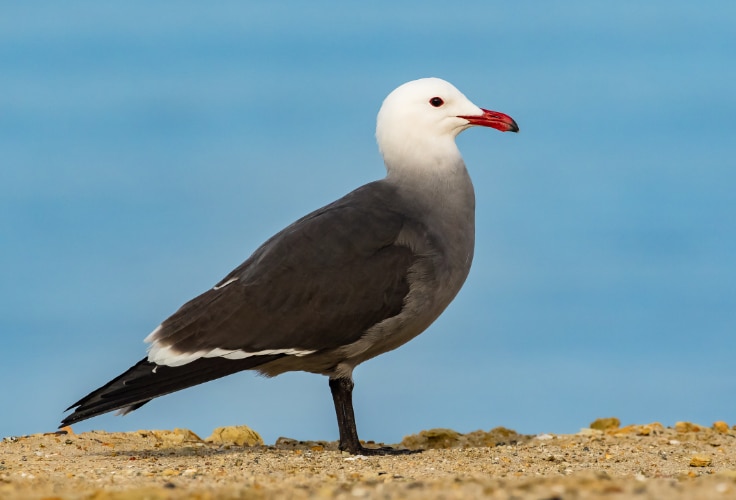
The Heermann’s gull is one of the most distinctive gulls of the Pacific coast, striking for its smoky-gray body, gleaming white head in breeding season, and vivid red bill tipped in black. Adults measure 46 to 53 centimeters (18.1 to 20.9 inches) in length, with males noticeably heavier than females. Among North American gulls it is unique for its consistently dark underparts and underwings, setting it apart even at long range.
In full breeding plumage, adults show a clean white head and upper neck contrasting with a slate-gray body, black tail with a crisp white tip, and black wings marked with small white spots at the tips. The bill is deep red with a dark tip, legs are black, and the eyes are dark brown. Non-breeding adults are similar but with smudgy gray mottling on the head. Immature birds are uniformly dark brown with buff-edged feathers and a dusky red or pinkish bill that gradually brightens with age; by the third year they resemble adults but often retain some mottling. Sexes look alike.

These gulls are highly social and most often encountered in flocks along beaches or foraging just offshore. They fly with strong, buoyant wingbeats and frequently glide close to the waves. Foraging often involves dramatic plunge-dives into nearshore waters or hovering over surf to snatch fish, and they are well known for stealing prey from brown pelicans as the larger birds surface with fish. Calls are varied and include catlike whines, rolling laughs, and harsh two-noted cries, especially conspicuous at colonies. Their diet is dominated by small schooling fish such as sardine, anchovy, and smelt, but they also take crustaceans, squid, insects, and occasionally eggs of terns and other gulls.
Breeding is concentrated almost entirely on Isla Rasa in the Gulf of California, Mexico, where 90-95% of the world’s population nests, with smaller colonies on other Mexican islands and a few recent attempts along the California coast. Nests are placed on rocky, sparsely vegetated ground in dense colonies, often in open sites with minimal shelter. After breeding, most birds disperse northward along the Pacific coast, reaching California in large numbers and regularly occurring as far north as Oregon, Washington, and British Columbia. A few wander farther inland, with rare records as far east as the Great Lakes and Florida.
Although numbers have increased since historic lows in the early twentieth century, the species remains of high conservation concern because of its extreme dependence on a single island for reproduction. Past egg collecting devastated colonies until Isla Rasa was protected in 1964, and populations rebounded strongly in subsequent decades. Today, threats include introduced predators such as rats, overfishing of sardines and anchovies, and shifts in prey linked to climate change. Regional protections and continued monitoring of its restricted breeding range are vital for the species’ long-term security.
Great Black-Backed Gull
Larus marinus
- Identification: Enormous, heavy-bodied gull with black back and wings, white head and underparts, pale pink legs, and a massive yellow bill with red spot.
- Where found: Breeds along coasts and islands from Newfoundland and Quebec south to North Carolina and inland around the Great Lakes; winters widely along the Atlantic coast and large inland waters.
- How to spot: The world’s largest gull; note its bulk, thick bill, and dark back contrasting with white body; often dominates mixed flocks and aggressively displaces other gulls.
- Conservation status: Least Concern globally, but steep population declines in North America; vulnerable to overfishing, contaminants, and targeted control at colonies.
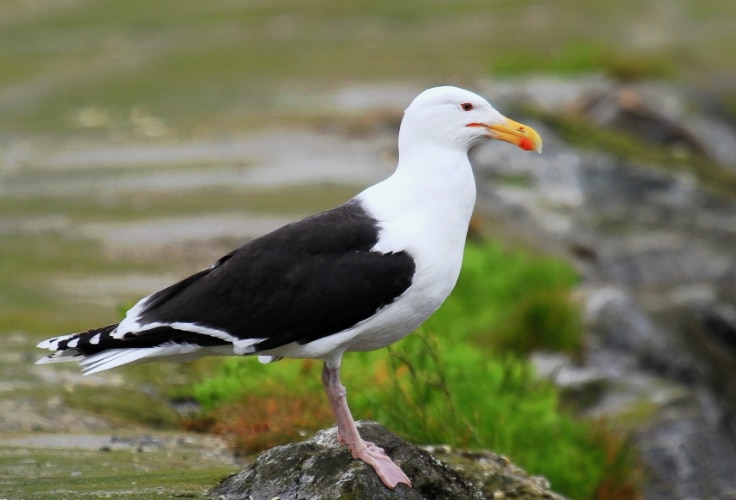
The great black-backed gull is the largest gull in the world and an unmistakable presence on North America’s northeastern coasts and the Great Lakes. Adults reach 71 to 79 centimeters (28.0 to 31.1 inches) in length with a wingspan of up to 1.7 meters (5.6 feet). Its sheer bulk, short tail, broad wings, massive head, and thick, rectangular bill distinguish it from all other gulls.
In breeding plumage, adults show a white head, body, and tail contrasting with an inky black back and wings, accented by broad white trailing edges and white mirrors in the outer primaries. The bill is yellow with a red spot near the tip, the eyes pale with a reddish orbital ring, and the legs pink. Winter adults are similar but may show faint gray spotting on the head and neck. Juveniles are heavily checkered in brown and white with dark wings and tail band, and a dark bill, becoming progressively more mottled before attaining full adult plumage in the fourth year. Males and females look alike, though males are larger.

In the field, this species is slow but powerful, often soaring with outstretched wings or gliding between heavy wingbeats. It dominates feeding flocks, frequently stealing prey from other seabirds and even attacking them directly. Calls resemble those of herring gulls but are deeper and harsher. Opportunistic and predatory, it feeds on fish, crabs, mollusks, sea urchins, carrion, refuse, and young birds, including eggs and chicks of other seabirds and waterfowl. Large prey such as shellfish or bird eggs are dropped on rocks to break them open. Around fishing vessels and landfills, it scavenges readily.
Breeding occurs on offshore islands, rocky coasts, and occasionally inland lakes. In Canada, colonies are widespread from Labrador and Quebec through the Gulf of St. Lawrence, Newfoundland, and the Maritimes, with smaller numbers along the Great Lakes. In the United States, nesting extends from Maine south to Virginia and North Carolina, mainly on islands and dunes. Colonies are typically loose, pairs nesting apart or in small groups, often interspersed with herring gulls, terns, or alcids. Nests are built on open ground beside rocks or shrubs for shelter. Wintering birds are common along the Atlantic coast from Newfoundland south to Florida and inland around the Great Lakes and major rivers.
Once nearly extirpated in North America by egg collecting and hunting in the 19th century, the species rebounded after protection and expanded its range southward through the 20th century, aided by refuse dumps and fishery waste. Populations peaked in the mid-1900s, but monitoring shows sharp declines over the past half-century, with losses exceeding 50% in North America. Threats include overfishing of prey species, contaminants, targeted control at nesting islands to protect terns and puffins, and climate-driven shifts in marine ecosystems. Though still widespread, the species is now considered a regional concern, requiring careful monitoring of its large but vulnerable populations.
Glaucous-Winged Gull
Larus glaucescens
- Identification: Large, pale gray gull with wingtips matching the color of the back, pink legs, dark eyes, and a heavy yellow bill with a red spot.
- Where found: Breeds from Alaska south along the Pacific coast to Oregon and inland around large lakes; winters widely along the North Pacific coast, especially Alaska, British Columbia, and Washington.
- How to spot: Look for the bulky build, pale uniform plumage, and gray wingtips the same shade as the back; often in coastal flocks, at harbors, and in city parks.
- Conservation status: Least Concern globally; overall populations stable, though threatened by pollutants, oil spills, and changing prey availability from climate change.
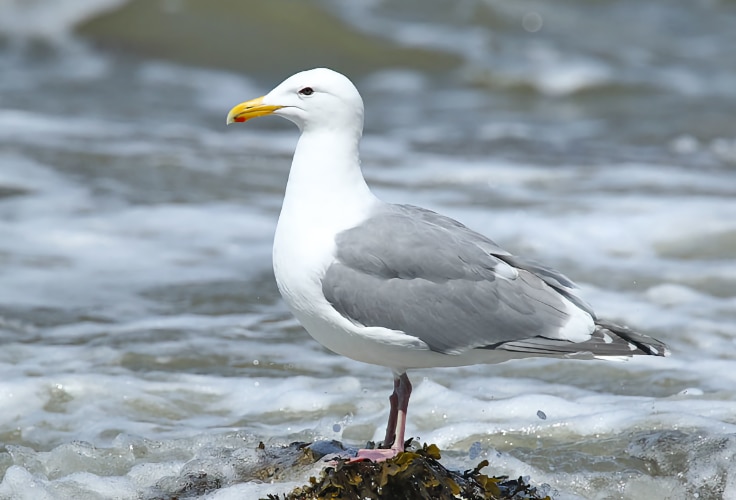
The glaucous-winged gull is the characteristic large gull of the North Pacific, common from Alaska through British Columbia and the Pacific Northwest. With a length of 50 to 68 centimeters (19.7 to 26.8 inches), it ranks among the largest North American gulls, showing a broad body, short rounded wings, and a heavy, blunt-tipped bill. Its uniform pale gray coloration makes it distinctive, though frequent hybridization with other large gulls often complicates identification.
Adults are white on the head, body, and tail, with a pale gray back and wingtips that are the same shade as the mantle. Broad white tips on the wing feathers form a subtle “string of pearls” effect in flight. The bill is dull yellow with a red spot, the legs are pink, and the eyes are dark. Non-breeding adults are heavily streaked on the head and neck. Juveniles are frosty gray-brown with dark bills and lack the black wing- and tail-markings typical of many young gulls, gradually passing through mottled stages before reaching adult plumage in their fourth year. Sexes are similar, with males larger.
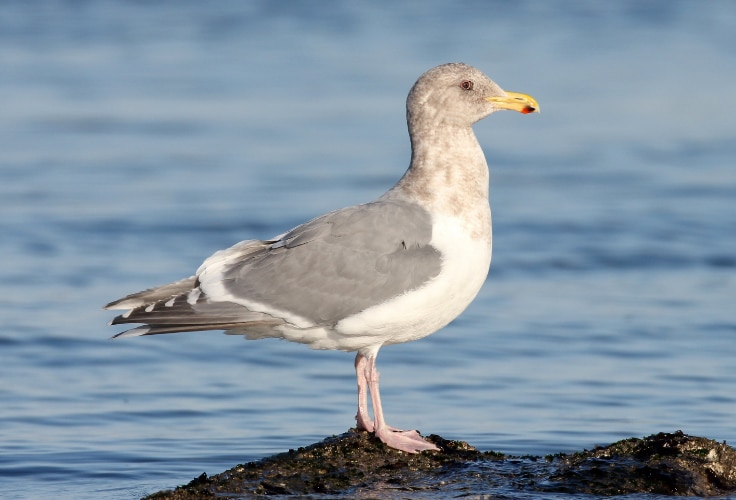
In the field, this species appears deliberate and heavy in flight, with slow wingbeats and frequent soaring. It floats high on the water and is adept at plunge-diving or seizing food at the surface. Calls resemble those of herring gulls but are slightly deeper and hoarser, including long laughing cries, plaintive mews, and harsh attack notes. Foraging is opportunistic: fish, crabs, mollusks, and barnacles are taken from shorelines and shallow waters; hard-shelled prey are dropped onto rocks to break them; refuse and fishery waste are exploited; and eggs or chicks of other seabirds are sometimes consumed. These gulls frequently gather in large flocks at harbors, landfills, and beaches.
The species breeds from the Bering Sea south through coastal Alaska and British Columbia to Washington and Oregon, nesting on offshore islands, cliffs, grassy meadows, and even rooftops. Colonies may hold thousands of pairs, often mixed with other seabirds. Nests are placed on open ground or sheltered beside rocks or vegetation. Outside the breeding season, glaucous-winged gulls are widely distributed along the North Pacific, wintering from the ice edge in the Bering Sea to California, with many remaining near their breeding sites year-round.
Populations are currently considered stable, and the species is not of high conservation concern. Still, it remains vulnerable to marine pollution, especially oil spills, and to long-term changes in fish stocks linked to climate change. Because it hybridizes extensively with western and herring gulls, shifts in population dynamics may influence its genetic integrity and complicate monitoring. For now, the glaucous-winged gull remains a familiar and abundant sentinel of the Pacific coast.
Western Gull
Larus occidentalis
- Identification: Large, stocky gull with dark gray back and wings, white head and underparts, pink legs, and a heavy yellow bill with a red spot.
- Where found: Strictly coastal along the Pacific from Washington to central Baja California; breeds mainly on offshore islands and rocky coasts, winters throughout the same range.
- How to spot: Look for the broad, dark gray back contrasting with white body and pink legs; usually seen around beaches, bays, and coastal towns, rarely inland.
- Conservation status: Least Concern globally; listed as Tipping Point species in North America due to steep long-term population loss, with threats from pollutants, changing prey, and El Nino-related food shortages.
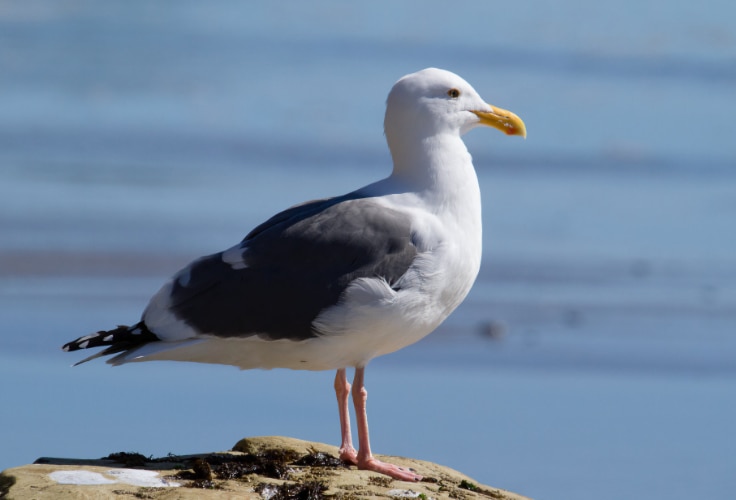
The western gull is one of the defining seabirds of the Pacific coast, a bulky, powerful gull that rarely strays inland. Adults measure 56 to 66 centimeters (22.0 to 26.0 inches) in length, with broad wings and a thick, heavy bill. It is often confused with related species in the region, especially where it hybridizes with the glaucous-winged gull in Oregon and Washington, but its darker gray upperparts and overall stockier build are good field marks.
Breeding adults show a gleaming white head, neck, and body, contrasting with dark slate-gray back and wings. The bill is yellow with a red subterminal spot, the iris pale with yellow to orange orbital rings, and the legs are pink. Non-breeding birds may show gray-brown streaking on the head. Immatures take four years to reach full adult plumage, passing through mottled brown and messy intermediate stages, with darker backs developing by the second year. Males and females look alike, though males are larger.
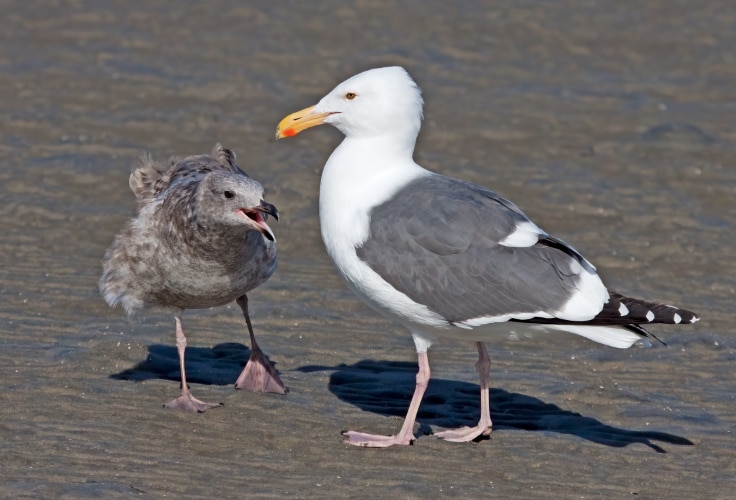
Western gulls are assertive, often dominating beaches, harbors, and fishing piers. They fly with deliberate wingbeats and extended glides, and form loose foraging flocks at sea, especially around feeding whales. Their vocal repertoire includes the classic long call familiar to most people, along with mews, choking calls, and harsh alarms. Feeding is highly opportunistic: they catch fish and squid at the surface, take crabs, mollusks, and intertidal invertebrates, scavenge at landfills, and occasionally prey on eggs, chicks, or small birds. Like other large gulls, they drop shellfish onto rocks to break them open.
Breeding occurs from northern Washington south along the Pacific to Baja California, almost entirely on islands, offshore rocks, and coastal cliffs. Colonies range from large dense gatherings, such as on Southeast Farallon Island off San Francisco, to isolated pairs nesting on rocky outcrops or rooftops. Nests are placed on well-drained ground, often sheltered by rocks or vegetation. During the non-breeding season, western gulls remain within the same coastal range, dispersing along beaches, bays, and estuaries, with many concentrating in central and southern California waters. Inland occurrences are rare and usually brief.
Once considered common, western gulls have declined in recent decades. Populations were reduced by the lingering effects of DDT and continue to be influenced by fluctuations in prey linked to El Nino events. Although still widespread along the Pacific coast, ongoing threats from marine pollutants, food shortages, and changing ocean conditions make careful monitoring of this species essential for its long-term survival.
Yellow-Footed Gull
Larus livens
- Identification: Large, dark-backed gull with white head and body, stout yellow bill with red spot, and bright yellow legs and feet.
- Where found: Breeds almost entirely on islands in the Gulf of California, Mexico; after breeding, some disperse north to coastal mainland Mexico and occasionally to the Salton Sea in California.
- How to spot: Look for the combination of dark slate-gray back and yellow legs, a trait not shared by other Pacific gulls; often around harbors, beaches, and rocky shores.
- Conservation status: Least Concern globally but restricted to a small range; vulnerable to disturbance at colonies, egg collecting, and changes in prey availability.
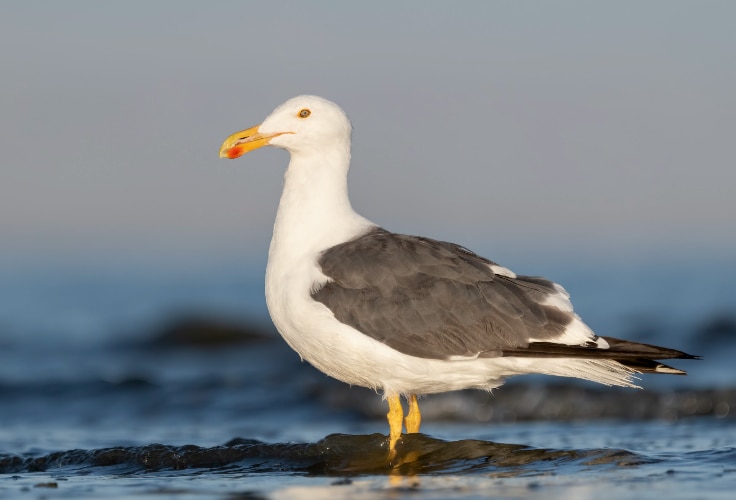
The yellow-footed gull is a distinctive Pacific gull, confined largely to the Gulf of California where it breeds on offshore islands and rocky islets. Measuring 53 to 72 centimeters (20.9 to 28.3 inches) in length, it is one of the larger North American gulls, with a stocky build and powerful bill. It is the only breeding gull in the region with both a dark gray mantle and bright yellow legs, setting it apart from the otherwise similar western gull.
Breeding adults show a clean white head, neck, and body contrasting with a dark slate-gray back and black wingtips, accented by white trailing edges. The iris is yellowish to golden, the orbital ring orange-yellow, and the bill bright yellow with a red subterminal spot. Non-breeding birds may develop light gray mottling on the head and neck. Juveniles are overall dark brown, but unlike western gulls they usually show more white on the belly and undertail; by the second year, the back becomes gray and the legs turn yellow, though young birds can be difficult to distinguish from western gulls.

Yellow-footed gulls are assertive coastal birds, most often seen around beaches, rocky intertidal zones, and harbors. They forage by surface-dipping, shallow plunge-diving, and walking along shorelines, feeding on fish, crustaceans, mollusks, carrion, and refuse. They also take eggs and chicks of seabirds nesting nearby and may scavenge from marine mammals or kleptoparasitize other seabirds. Calls are very similar to those of western gulls, including the familiar loud long call, mews, and choking displays during courtship.
The species breeds almost exclusively on islands in the Gulf of California, including Isla Espiritu Santo, San Pedro Nolasco, and numerous smaller islets. Colonies vary in size from a few to a few hundred pairs, often nesting near the high-tide line on beach ridges or rocky slopes. Although most pairs nest in loose colonies, some breed solitarily. Outside the breeding season, birds remain in the Gulf or disperse north along the Pacific coast of Mexico; small numbers reach the Salton Sea in southern California, where they occur regularly in summer and fall.
Despite its limited range, the species remains locally common in the Gulf of California. However, its dependence on a small set of breeding islands makes it vulnerable to disturbance. Past egg collecting and colony disruption reduced breeding success, and future threats include human disturbance, changing fish stocks, and coastal development. Continued protection of breeding islands and monitoring of food resources are essential to ensure the persistence of this localized but distinctive gull.
Black-Legged Kittiwake
Rissa tridactyla
- Identification: Small, graceful gull with pearl-gray back, white body, solid black wingtips, yellow bill, and black legs; wings more rounded and tern-like.
- Where found: Breeds on Arctic and subarctic cliffs across Alaska, Canada, and Newfoundland; winters widely offshore in the North Atlantic and North Pacific, reaching coasts as far south as California and Florida.
- How to spot: Look for its distinctive “dipped-in-ink” wing pattern, buoyant flight with stiff wingbeats, and nasal “kittiwake” call; immatures show a bold black collar.
- Conservation status: Vulnerable globally; major declines linked to warming seas and reduced prey; still abundant but showing long-term decreases in North America.
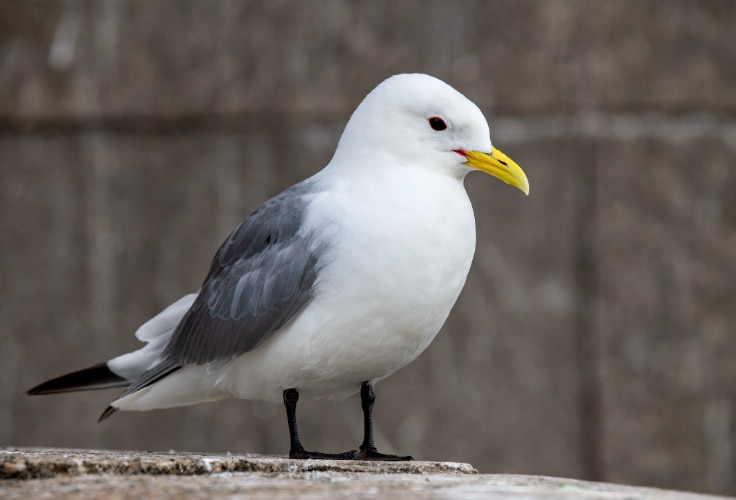
The black-legged kittiwake is the most pelagic gull of the Northern Hemisphere and the only truly oceanic gull regularly seen far offshore. Despite being the world’s most numerous gull, it is now declining in many regions. Adults are small, measuring 38 to 41 centimeters (15.0 to 16.1 inches) in length, with a slender build, rounded wings, and a short, slightly forked tail. Their three-toed feet give the species its scientific name tridactyla.
Adults in breeding plumage are immaculate white on the head, body, and tail, with a soft pearl-gray mantle and upperwings and sharply contrasting black wingtips that look as if dipped in ink, lacking the white “mirrors” seen in many gulls. The bill is greenish yellow and the legs black. In non-breeding plumage, adults develop a gray smudge around the ear and nape. Juveniles are strikingly patterned, with a dark “M” across the upperwings, black outer primaries, and a crisp black collar across the nape. Plumage differences between sexes are minimal.
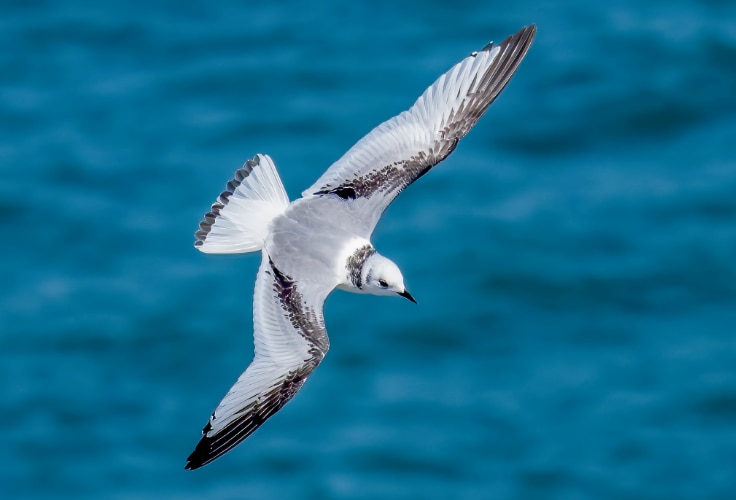
Kittiwakes are highly social and noisy at colonies, where their sharp “kittiwake” calls echo constantly and serve as the source of their name. In flight, they are buoyant and tern-like, with faster and stiffer wingbeats than larger gulls. They feed mostly at sea, often in flocks, seizing or plunging onto small fish and crustaceans at the surface, including capelin, herring, krill, and squid. Unlike many gulls, they rarely scavenge at landfills and depend instead on natural marine prey.
In North America, breeding colonies are concentrated on sheer cliffs in Alaska, the Canadian Arctic, Hudson Strait, Newfoundland, and the Gulf of St. Lawrence. They also nest in Greenland. Nests are compact mud-and-vegetation cups placed on narrow ledges, often in dense colonies where neighboring nests touch. After breeding, birds disperse widely at sea. Wintering birds range along the Pacific coast from British Columbia to Baja California, and in the Atlantic from Newfoundland and Greenland south to Florida, often occurring far offshore. Inland records are rare and usually involve storm-driven vagrants.
Although still numerous, black-legged kittiwakes have undergone sharp declines in recent decades, particularly in the North Atlantic, where warming seas and shifting fish populations reduce food availability. In North America, some Alaskan and Canadian colonies remain strong, but regional decreases mirror global patterns. Long-term survival depends on stable marine ecosystems, with conservation attention focused on fisheries management, monitoring of colonies, and climate-driven shifts in ocean productivity.
Glaucous Gull
Larus hyperboreus
- Identification: Huge pale gull with very pale gray back, pure white wingtips, thick yellow bill, pale eye, and pink legs; immatures are whitish with buff markings and a pink-and-black bill.
- Where found: Breeds across the High Arctic of Alaska, Canada, Greenland, and Eurasia; winters south along both Atlantic and Pacific coasts to the northern United States, occasionally farther inland.
- How to spot: Look for a bulky, broad-winged gull with white wingtips (unlike most gulls), shorter primary projection than Iceland Gull, and powerful flight; often dominant in mixed flocks.
- Conservation status: Least Concern globally but declining in parts of its range; pressures include contaminants, changes in Arctic ecosystems, and persecution near eider colonies.

The glaucous gull is the largest white-winged gull in North America and a familiar presence in Arctic coastal regions. With a body length of 64 to 77 centimeters (25.2 to 30.3 inches), it rivals the great black-backed gull in size. Its heavy, straight-sided bill and long-legged, deep-chested stance give it a blunt, powerful look, further emphasized by a flat-crowned head and fierce expression.
Breeding adults are mostly white with a very pale gray mantle and back and gleaming white wingtips, lacking the black seen in most gulls. The bill is yellow with a red spot, the eyes yellow with a colored orbital ring, and the legs pink. In winter, the head becomes lightly mottled brown. Immatures are pale buff to whitish, barred with light brown, and show a pink bill with a sharply defined black tip, gradually fading as adult plumage develops over four years. Males and females are similar, with size the only consistent difference.

Glaucous gulls are strong, dominant birds in the field, often outcompeted only by great black-backed gulls. They fly with broad, blunt-tipped wings and spend much time gliding. Calls include harsh alarms, piercing trumpeting long calls, and shrill cries when threatened. Their diet is broad: fish, mollusks, invertebrates, carrion, eggs and chicks of seabirds and waterfowl, small mammals, and refuse. They frequently pirate prey from other seabirds and scavenge at coastal settlements, harbors, and dumps.
This species breeds widely across the Arctic, from Alaska and northern Canada through Greenland, nesting on cliffs, tundra shores, islands, and sometimes inland lakes. Nests are defended vigorously against predators and neighbors, and pairs often return to the same sites year after year. After breeding, birds disperse south with ice cover, wintering mainly along Atlantic coasts from Labrador to the mid-Atlantic states and along the Pacific coast from Alaska through British Columbia, with smaller numbers reaching the Great Lakes and occasionally farther south. Most wintering birds seen in temperate regions are immatures.
Although still widespread, glaucous gull populations are declining in several regions, with the species flagged as a concern in recent assessments. As top Arctic predators, they accumulate high levels of pollutants such as PCBs, mercury, and organochlorines, which impair reproduction. They are also deliberately culled in parts of Greenland and Russia to protect eider colonies, and changing sea-ice conditions threaten food supplies. Conservation attention centers on monitoring Arctic colonies and reducing exposure to contaminants, while shifts in the Arctic environment continue to shape the species’ future.
Iceland Gull
Larus glaucoides
- Identification: Medium-sized pale gull with rounded head, slender bill, light gray back, and whitish wingtips; immatures are very pale with buff barring and a dark bill.
- Where found: Breeds on cliffs in the Arctic of Canada and Greenland; winters along both coasts of North America, especially Atlantic Canada, the Great Lakes, and occasionally as far south as the U.S. mid-Atlantic and Pacific states.
- How to spot: Look for its dainty build, small bill, and buoyant flight; differs from larger Glaucous Gull by slimmer bill, longer wing projection past the tail, and more delicate expression.
- Conservation status: Least Concern globally; sensitive to oil spills and contaminants, though major colonies remain stable.
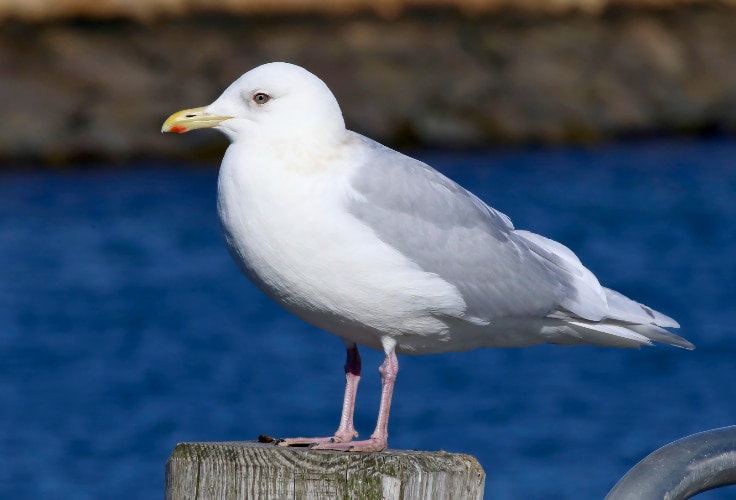
The Iceland gull is the daintier of the white-winged gulls in North America and is often confused with the larger glaucous gull. Measuring 50 to 60 centimeters (19.7 to 23.6 inches) in length, it shows a slimmer build, small rounded head, and slender bill that distinguish it from its bulkier Arctic relative.
Breeding adults are pale gray above with white head, body, and tail and broad white wingtips, creating an overall frosty look. The bill is yellow with a red spot, and the legs are usually pink or grayish. In winter, adults develop light streaking on the head and often a dusky mark before the eye. Juveniles are pale buff to whitish with light brown barring on the back and wings, a dark bill with a paler base, and a generally delicate, pale appearance.
Plumage differences occur across its range: the western form (L. g. thayeri) is darker gray with dark wingtips, the intermediate kumlieni (L. g. kumlieni) of eastern Canada (the form most often encountered in North America) shows variable gray in the wingtips, and the eastern nominate (L. g. glaucoides) is very pale.
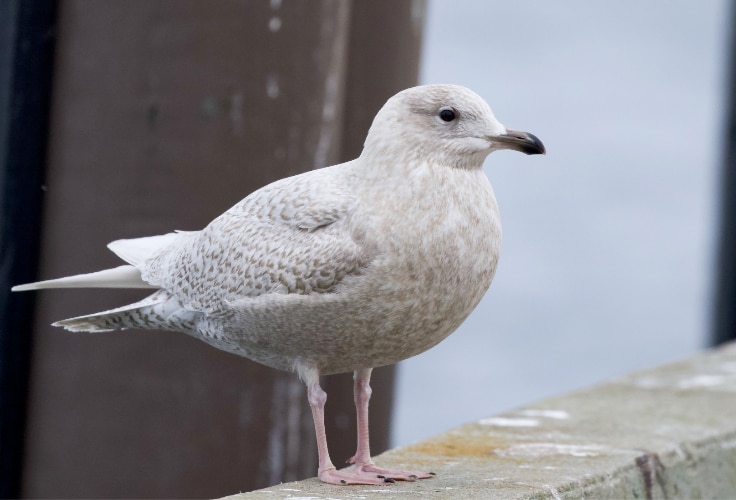
In the field, Iceland gulls are graceful, with quicker, lighter wingbeats than glaucous gulls. They often patrol coastlines or hover low over the water, picking fish or carrion from the surface and swallowing prey in flight. Unlike more aggressive gulls, they are less predatory and more specialized as surface feeders. Calls include nasal short notes and a squealing long call, higher-pitched and faster than those of larger gulls.
The species breeds on steep Arctic cliffs in Canada’s Arctic Archipelago and Greenland, nesting in loose colonies or solitary pairs on ledges and rocky islands. Nests are built of vegetation and lined with softer material. In winter, Iceland gulls occur widely along both coasts of North America, from Newfoundland and the Gulf of St. Lawrence south to the mid-Atlantic states, and from Alaska and British Columbia south to Oregon and occasionally California. They are also regular on the Great Lakes and scattered inland reservoirs, though rarely abundant.
Overall abundance is moderate, with limited long-term monitoring due to the remoteness of breeding areas. Populations appear stable in many regions, though the species is vulnerable to marine oil spills, which contaminate surface food, and to pollutants that accumulate in Arctic food chains. Past hunting reduced some Greenland colonies, but inaccessibility spared others. Continued monitoring and protection of Arctic breeding cliffs and marine habitats are key to maintaining healthy populations.
Black-Headed Gull
Chroicocephalus ridibundus
- Identification: Small gull with white body, pale gray back, red bill and legs, and dark chocolate-brown hood in breeding season; non-breeding shows white head with a dark ear spot.
- Where found: Common across Europe and Asia; in North America, breeds in Newfoundland and winters locally in the northeast, with vagrants south to the U.S. mid-Atlantic, Gulf Coast, and Caribbean.
- How to spot: Look for the brown (not black) hood in summer, red bill and legs, and prominent white blaze along the leading edge of the wing; often in flocks, sometimes among Bonaparte’s gulls.
- Conservation status: Least Concern globally; stable overall, though vulnerable to pollutants, disease outbreaks, and local disturbances.
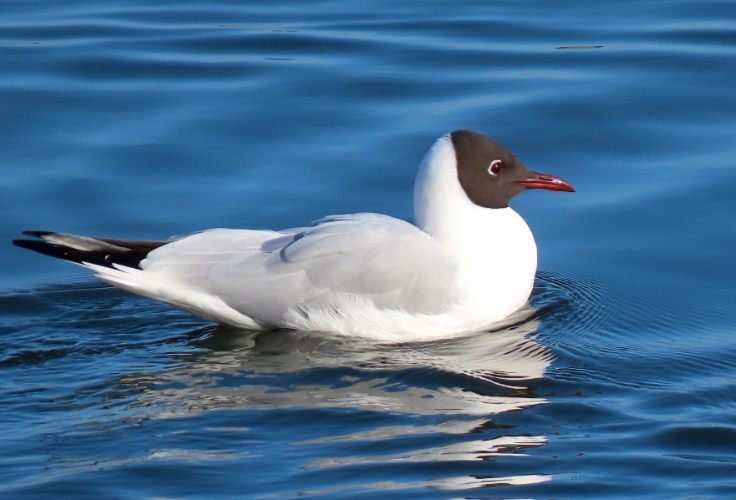
The black-headed gull is the familiar small hooded gull of Eurasia, and in North America it is best known as a scarce breeder and regular winter visitor in the northeast. Adults measure 37 to 43 centimeters (14.6 to 16.9 inches) in length and appear daintier than ring-billed or herring gulls, with slim proportions and buoyant flight.
In breeding plumage, adults show a dark chocolate-brown hood with narrow white crescents around the eyes, pale gray back and wings with black-tipped outer primaries, white body, and bright red bill and legs. In winter, the hood is lost, leaving a white head marked by a small dark ear spot and dusky smudging on the nape. Juveniles are buff and brown, with dark tertials and a distinct black tail band. First-year birds combine pale gray backs with dark wing and tail markings, while second-year birds resemble adults but may retain dark primary markings.
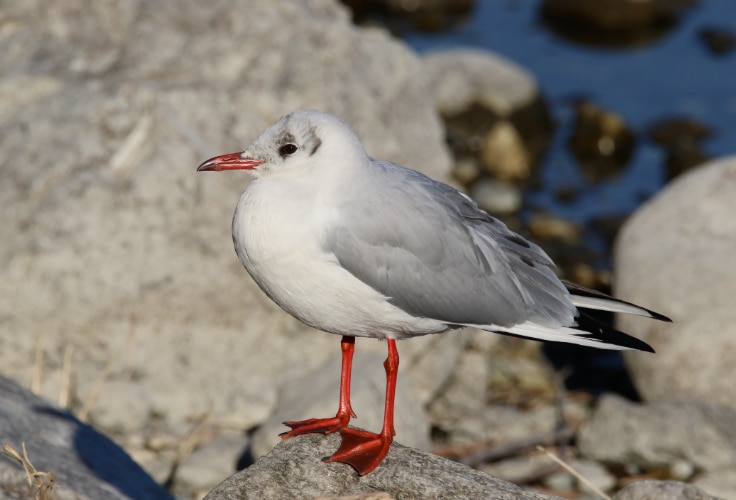
This species is active and noisy, its colonies filled with harsh, downslurred “kreeeaarh” calls. In flight, it shows long white leading edges to the wings, a key field mark, and often hovers or flycatches insects on the wing. Diet is broad and opportunistic, ranging from aquatic insects and earthworms in the breeding season to fish, marine invertebrates, berries, and scraps in winter. Birds feed in wetlands, fields, and intertidal areas, follow ploughs and fishing boats, and regularly scavenge at harbors, sewage outfalls, and landfills.
In North America, the main breeding presence is in Newfoundland, where the species nests in colonies on lakes and marshes. Elsewhere, it appears as a wintering or migrant visitor from the northeast United States south to New Jersey, with vagrants reaching Florida, the Gulf Coast, the Caribbean, and occasionally inland reservoirs. The species breeds widely across Europe and Asia, often in large colonies near lakes, marshes, and coastal wetlands, and winters south to Africa, India, and Southeast Asia.
Overall numbers are stable, and in some regions the species has expanded into new habitats such as sewage ponds and artificial wetlands. However, it is sensitive to pollution, oil spills, and disease outbreaks, and historically suffered local declines from egg collecting. In North America, its limited breeding distribution makes it a local rarity, but wintering flocks in the northeast provide birders with regular opportunities to encounter this small, distinctive gull.
Little Gull
Hydrocoloeus minutus
- Identification: Tiny, compact gull with short bill, short rounded wings, and striking dark gray to black underwings; breeding adults show a black hood and pale gray back with white wingtips.
- Where found: Primarily Eurasian; in North America scarce and local, breeding sporadically around the Great Lakes – St. Lawrence and Hudson-James Bay lowlands, with migrants and winterers on the Great Lakes and Atlantic coast and rarer along the Gulf and Pacific.
- How to spot: Seek the smallest gull in mixed flocks of Bonaparte’s – note the deep, uniform dark underwing, rounder wings, and smaller size; juveniles show a bold “M” pattern across the upperwings.
- Conservation status: Least Concern globally; North American numbers variable and generally lower than in the 1990s, with wetland loss and disturbance as key concerns.
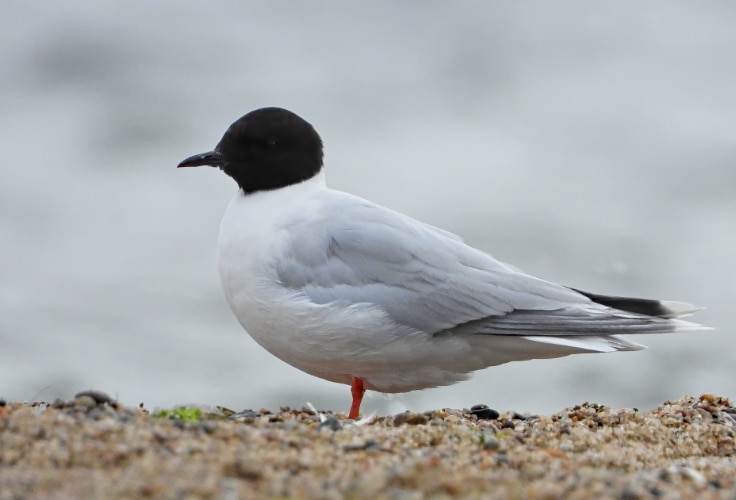
The little gull is the world’s smallest gull and an occasional breeder and regular migrant-winter visitor in northeastern North America. Its diminutive size, 25 to 30 centimeters (9.8 to 11.8 inches) in length, plus a petite bill and short, rounded wings make it notably daintier than Bonaparte’s or black-headed gulls in mixed flocks.
Adults in breeding plumage carry a neat black hood, pale gray mantle and upperwings, white wingtips, and wholly dark gray to black underwings, with bright red legs and a short dark bill; a faint peachy flush can tint the underparts. Non-breeding adults lose the hood, retaining a white head with a dark ear patch and dusky cap. Juveniles are barred and brown above with a black tail band and a strong dark diagonal across the wing coverts that forms an “M” in flight; first- and second-cycle birds transition toward the adult pattern over three years.
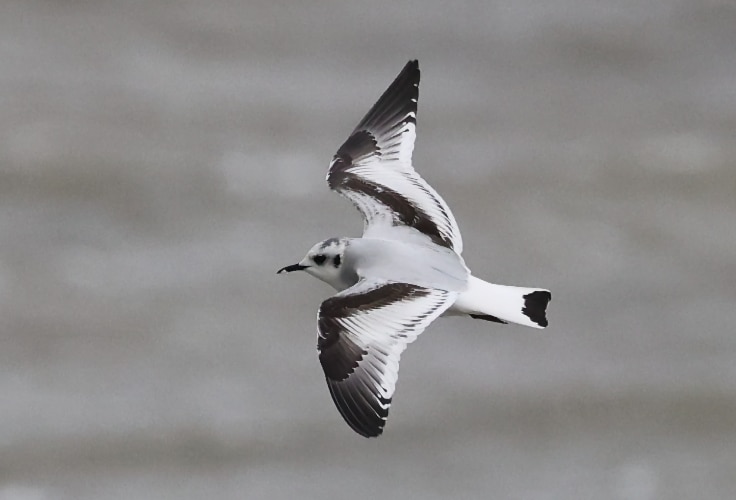
In the field, expect buoyant, agile, tern-like flight with deep wingbeats, brief hovering, and frequent surface-dipping. Birds often patter along the water like a small petrel and may spin while swimming as they pick insects from the surface. Vocal repertoire is varied; typical sequences include a clear, carrying long call in aerial display and sharp, ticking alarm notes near nests. Diet is flexible but leans on flying insects, small fish, and aquatic invertebrates, taken by dipping and occasional shallow plunge-dives, and opportunistically around outfalls, ferries, and rapids.
In North America, confirmed nesting has been sporadic and centered on the Great Lakes – St. Lawrence system, with additional records from the Hudson and James Bay lowlands and southern Minnesota; many years pass with no confirmed breeding. Birds favor large freshwater marshes with cattail and bulrush, often near or among tern colonies, placing nests on floating mats, low islets, or muskrat structures. Outside the breeding season, most occur on the Great Lakes and along the Atlantic from New England to the Carolinas, with smaller numbers along the Gulf and the Pacific Northwest. Winter use of coastal waters, estuaries, and beaches contrasts with the inland marsh preference in summer.
Abundance in North America is low and irregular, with winter and migration counts fluctuating annually and generally below peaks reported in the 1990s. Threats mirror those facing marsh-nesting terns: drainage and alteration of wetlands, boating disturbance, changing prey communities, and localized pollution. Protecting and managing large emergent marshes and maintaining water quality benefit this species and its frequent tern associates, helping sustain its scattered North American presence.
Sabine’s Gull
Xema sabini
- Identification: Small, long-winged gull with a sharp white triangle across the inner upperwing contrasting with black outer primaries, a subtly notched tail, and a black bill tipped yellow; flight is buoyant and tern-like.
- Where found: Breeds on Arctic tundra from western and northern Alaska across arctic Canada to Greenland; migrates mostly offshore and winters far at sea over cool upwelling zones, with rare winter records along North American coasts.
- How to spot: Scan pelagic flocks for a compact gull flying low with steady deep wingbeats; the flashing white inner wing is diagnostic, while juveniles add a crisp scaly back and a bold black tail band.
- Conservation status: Least Concern globally; with principal risks from marine oil spills, pollutants, and climate-driven changes to Arctic wetlands and ocean food webs.

The Sabine’s gull is a pelagic-leaning small gull best known to North American birders from offshore passages and Arctic breeding wetlands. Adults measure 27 to 33 centimeters (10.6 to 13.0 inches) in length and show long, narrow, pointed wings, a shallowly notched tail that is easiest to see at close range, and a neat black bill with a yellow tip.
Breeding adults have a dark gray hood edged behind by a narrow black line, dark pearl-gray mantle and inner wing coverts, white underparts, and upperwings that flash a large white triangle set off by black outer primaries with white tips. Underwings are mostly whitish with narrow black tips. In non-breeding plumage the head becomes largely white with dusky patches on the nape and ear coverts. Juveniles are brown-scaled above with barred coverts, a clean white rump, and a broad black terminal tail band that accentuates the notch; first-winter birds gain a gray “saddle” while retaining browner wing coverts.
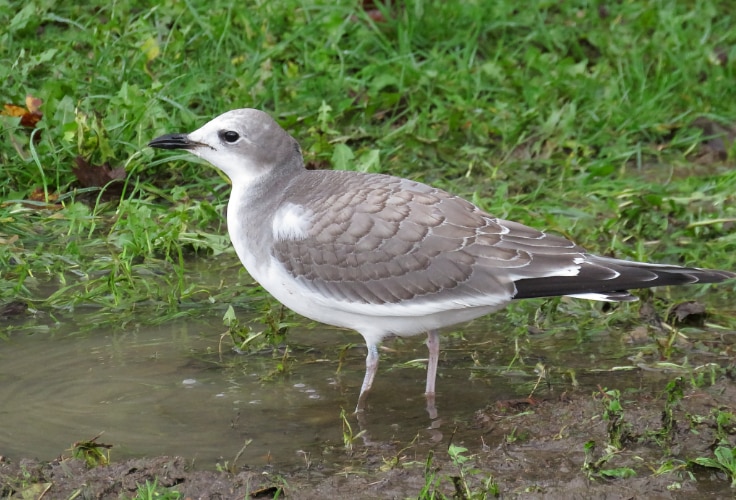
In the field the species flies low with continuous, even wingbeats and little soaring, often hovering briefly over prey and dipping to the surface to seize items. On breeding ponds it may spin phalarope-like while picking from the surface. Vocalizations are thin and rattling, more tern-like than gull-like, including chirring notes and a mechanical, winding quality in display. Diet on the tundra centers on aquatic insects and their adults; at sea it takes zooplankton, small fishes, crustaceans, and offal by surface-seizing.
Within North America, breeding occurs from coastal western and northern Alaska east across the Canadian Arctic to Greenland, typically on mossy edges of small freshwater or brackish ponds, low islets, and marshy peninsulas. After fledging, birds move to coasts and migrate largely offshore. Wintering is far at sea over cool upwelling systems, notably along the Humboldt Current in the eastern Pacific and the Benguela Current in the eastern Atlantic; individuals are only occasionally recorded in winter along Pacific, Atlantic, or Gulf coasts, and migrants sometimes appear on large inland lakes after storms.
Abundance is difficult to measure because nesting areas are remote and most of the year is spent offshore. Current assessment places the species at low conservation concern, but exposure to marine oil spills and contaminants and the sensitivity of both Arctic wetlands and upwelling-driven food webs to climate change present ongoing risks. Protecting tundra wetland complexes and reducing marine pollution are central to maintaining this distinctive gull’s North American presence.
Ivory Gull
Pagophila eburnea
- Identification: Medium-sized, stocky gull that is entirely white as an adult, with a heavy bluish-green to slate bill tipped yellow and black legs.
- Where found: Breeds in the Canadian High Arctic and occurs elsewhere across Greenland and Svalbard; outside breeding, keeps to pack-ice edges in the northwest Atlantic and the Bering–Chukchi seas, with rare wanderers farther south.
- How to spot: Look for a gleaming all-white gull over sea ice or at glacier fronts and seal carcasses; on the ground it stands upright with a pigeon-like profile and short black legs; flight is smooth and powerful.
- Conservation status: Near Threatened globally; marked long-term decline with chief risks from sea-ice loss, Arctic pollutants, and oiling.
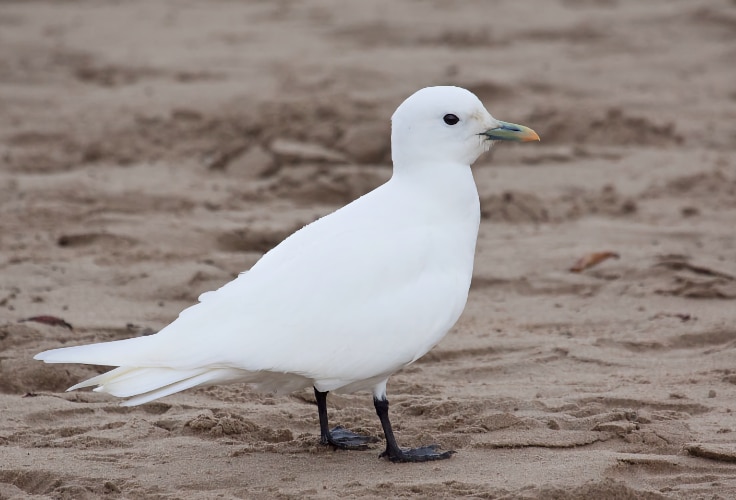
The ivory gull is the only gull that is pure white in adult plumage and a signature species of the High Arctic pack ice. Adults measure 40 to 43 centimeters (15.7 to 16.9 inches) in length and appear compact and short-legged with a rounded crown, dark iris, and long wing tips that project beyond the tail when perched. The bill is heavy, bluish-green to slate with a yellow tip, and the legs are black.
Adults remain entirely white year-round apart from occasional staining. Juveniles (first winter) contrast sharply, showing a dark face mask, scattered black spotting on the upperparts and flight feathers, and a narrow black subterminal tail band that together create the classic “ermine” look; adult-like plumage is reached on a two-year cycle. At all ages, the tibia is fully feathered to the joint, and there is little or no sexual dimorphism.

In the field, expect a clean white gull coursing along ice edges with firm, graceful wingbeats. Birds often alight at seal or whale carcasses and can be confiding at feeding sites. On land they walk with a waddling, pigeon-like gait. Vocalizations are varied; a typical call is a harsh, disyllabic “kee-urr,” more tern-like than the voices of larger gulls. Feeding is opportunistic: small fish and invertebrates taken near the surface at ice leads and floe edges, supplemented by scavenging marine mammal offal and bird remains; plunge-diving is not characteristic.
In North America the breeding stronghold is in Arctic Canada, with colonies on Ellesmere, Devon, Cornwallis, Seymour, and northern Baffin islands. Elsewhere it nests sparsely in Greenland and Svalbard. Nest sites are remote and predator-poor – crevices and ledges on inland cliffs, stony ridges, and occasionally gravel on sea ice or even icebergs. Outside the breeding season, most birds remain with pack ice, wintering along the ice edge from the Labrador Sea to Davis Strait and in the Bering and Chukchi seas. Vagrants reach Atlantic Canada and the northeastern United States, with scattered inland records, mainly in mid-winter.
Abundance has declined over recent decades, though numbers can fluctuate with sea-ice extent and prey availability. Key pressures include the loss and shifting of pack ice that structure foraging areas, exposure to bioaccumulated pollutants concentrated in the Arctic, and the risk of oiling at sea. Conservation priorities center on maintaining intact ice-edge habitats and water quality, minimizing pollutant inputs and spills, and protecting remote nesting cliffs and nunatak sites across the High Arctic.
Lesser Black-Backed Gull
Larus fuscus
- Identification: Medium-sized, long-winged gull with dark gray back, black wingtips, yellow legs, and yellow bill with red spot; slimmer build and more graceful than herring gull.
- Where found: Breeds in western Europe and Iceland; winters from Europe to West Africa; now increasingly regular on the Atlantic coast of North America, from Newfoundland to Florida, with scattered inland and Pacific records.
- How to spot: Look for its smaller, slender build, long pointed wings, dark gray mantle, and bright yellow legs; often mixed into flocks of herring and great black-backed gulls.
- Conservation status: Least Concern globally; expanding range with increasing numbers in North America, though some European populations have declined.
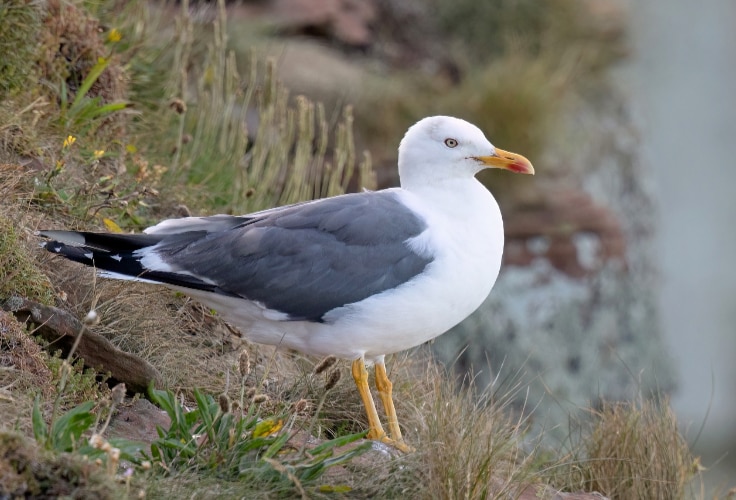
The lesser black-backed gull is a graceful, slender relative of the herring gull and has become an increasingly familiar sight on North America’s Atlantic seaboard. Adults measure 51 to 64 centimeters (20.1 to 25.2 inches) in length, with long pointed wings and a slimmer frame than the herring gull, giving a more attenuated appearance both in flight and at rest.
Breeding adults of the graellsii subspecies (L. f. graellsii), the form most often seen in North America, show a medium-dark gray mantle, contrasting black wingtips, yellow legs, yellow bill with a red spot, and a bright yellow iris with red orbital ring. In winter, the head and neck become lightly streaked. Immatures resemble young herring gulls but are darker overall, with more uniform brown tones and less distinct pale edging on the feathers. They take four years to reach full adult plumage.
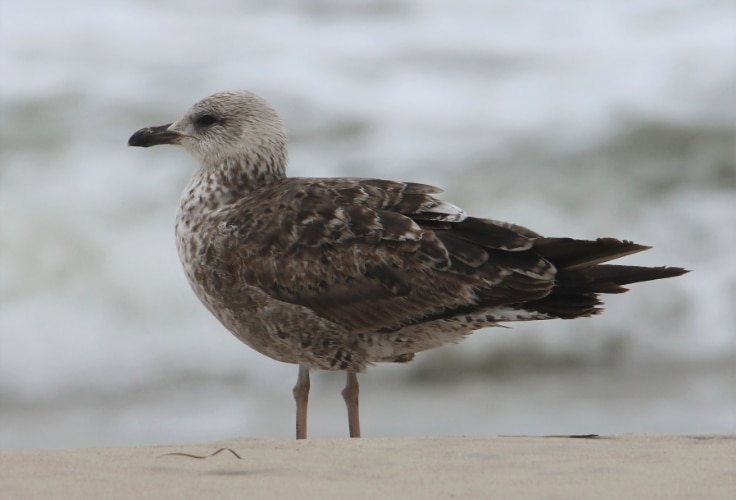
In the field, this gull is agile and buoyant, with long, pointed wings and faster wingbeats than the heavier herring gull. Calls are nasal and lower-pitched versions of herring gull cries. Foraging is opportunistic, with a diet of fish, invertebrates, carrion, and refuse. Birds often scavenge at landfills, patrol harbors and beaches, or forage at sea. They mix freely with other large gulls, though they are usually less dominant than herring and great black-backed gulls.
Although widespread and abundant in Europe, the species remains a newcomer to North America. Most individuals seen here are graellsii from Iceland and western Europe, arriving in late summer or fall and wintering along the Atlantic coast from Newfoundland to Florida. They are now regular winter visitors in the mid-Atlantic region and are increasingly recorded on the Great Lakes and inland reservoirs. There are also rare records from the Gulf Coast, Caribbean, and Pacific states, including Alaska. Despite this increase, confirmed breeding in North America is absent, apart from a few mixed pairs with herring gulls on islands off Maine.
Globally, lesser black-backed gulls are generally stable or increasing, especially in western Europe where they have expanded in both breeding and wintering ranges. Some populations, such as the Baltic breeding race (fuscus), have declined sharply due to pesticides and predation, but the graellsii subspecies continues to thrive. In North America, their numbers are still small but steadily rising, reflecting both transatlantic dispersal and adaptation to coastal and urban food sources.
Ross’s Gull
Rhodostethia rosea
- Identification: Small, delicate gull with wedge-shaped tail, buoyant tern-like flight, pale gray upperparts, and in breeding plumage a rosy wash on the underparts and a narrow black collar.
- Where found: Breeds sparsely in northeast Siberia, northern Greenland, and irregularly in the Canadian High Arctic; winters mainly along the edges of pack ice, with rare vagrants south into North America, Europe, and Asia.
- How to spot: Look for a graceful, tern-like flyer with a distinctive wedge-shaped tail and, in breeding adults, a rosy belly and neat black collar; juveniles show a bold black “M” across the upperwing.
- Conservation status: Least Concern globally; true numbers are difficult to assess, with main concerns centered on climate change, oil development, and predation at colonies.

The Ross’s gull is one of the rarest and most beautiful gulls seen in North America, sought by birders for its delicate form and unique coloration. Adults are 29 to 32 centimeters (11.4 to 12.6 inches) long, with slender, pointed wings and a buoyant, tern-like flight style. Its wedge-shaped tail is distinctive but can be subtle at distance.
Breeding adults display a soft rosy wash across the underparts, most intense on the breast and belly, set off by pale gray upperparts and a narrow black collar around the neck. The bill is small and black, the legs coral-red, and the iris dark with a reddish orbital ring. Non-breeding adults lose the pink flush and the collar, instead showing a pale gray crown with flecks and a small dark ear spot. Juveniles resemble little gulls but differ in having a wedge-shaped tail tipped black only on the central feathers and a broad dark “M” across the upperwing.
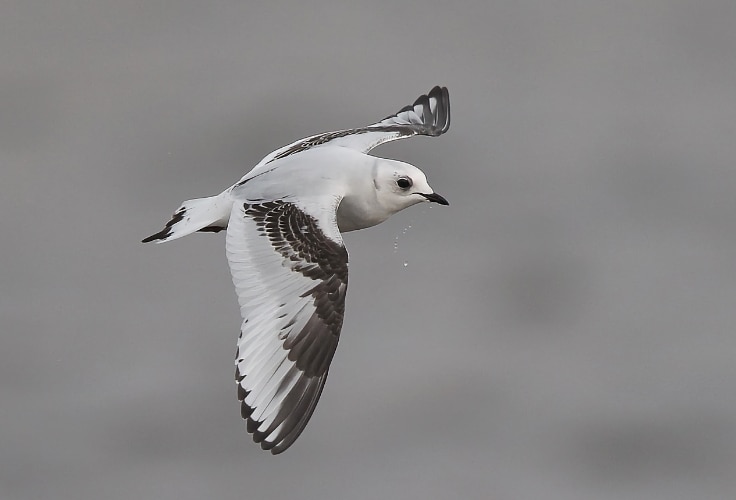
In the field, Ross’s gull is buoyant and graceful, often recalling a tern with its steady, elastic wingbeats. Calls are high-pitched, yapping, and musical compared to most gulls, with a short “a-dac” or a tern-like “kik-kik-kik” as alarm. Diet varies by season – mainly insects in the breeding tundra, shifting to small marine invertebrates, plankton, and small fish at sea. Birds forage by dipping and surface-seizing, sometimes joining Sabine’s gulls or phalaropes at productive patches of water or scavenging around marine mammal remains.
Breeding occurs in extremely remote colonies in marshy tundra of northeast Siberia, northern Greenland, and irregularly in the Canadian Arctic on Baffin and adjacent islands. Colonies are small, often only a handful of pairs, nesting in damp tundra around pools or deltas, sometimes near Arctic terns or shorebirds. Nests are built of grasses and mosses on tussocks or hummocks, well spaced from neighbors and deliberately inconspicuous.
Abundance is poorly understood because colonies are so scattered and much of the life cycle is spent over inaccessible pack ice. Counts at migration points, such as Point Barrow in Alaska, occasionally reveal thousands moving through, suggesting larger populations offshore. Threats include climate-driven changes to sea ice and tundra, predation from foxes, jaegers, and larger gulls, and disturbance or habitat loss from petroleum development. Safeguarding fragile tundra breeding areas and reducing risks from Arctic industrial expansion remain central to the species’ long-term outlook.
Slaty-Backed Gull
Larus schistisagus
- Identification: Large, stocky gull with a dark slaty-gray back, thick yellow bill with red spot, bright pink legs, and bold white spots across the wingtip; underwing tricolored with white linings, gray remiges, and white-tipped primaries.
- Where found: Native to coastal northeast Asia from Kamchatka and the Sea of Japan south to Honshu; breeds mainly in Russia and Japan, with regular occurrences in western Alaska and rare wanderers along both North American coasts.
- How to spot: Look for a bulky gull with short wings, rounded head, and intense pink legs; in flight the distinctive wingtip pattern shows a line of white spots separating slate gray from black.
- Conservation status: Least Concern globally; populations appear stable, though locally subject to pressures from fisheries and disturbance at colonies.

The slaty-backed gull is one of the heaviest-bodied gulls occurring in North America, seen mostly as a scarce visitor from its strongholds in northeast Asia. Adults measure 55 to 67 centimeters (21.7 to 26.4 inches) in length and show pronounced sexual size dimorphism, with males bulkier than females. In the field the species looks pot-bellied and thickset, with a rounded crown and relatively short wings.
Breeding adults are white-headed with a dark slaty mantle and wings, black-tipped primaries, and a diagnostic wingtip pattern: a line of white spots across the outer primaries produces the “string of pearls” effect. The tertials are broadly edged white, forming large white crescents near the wingtip. The bill is yellow with a red gonydeal spot, and the legs are a bright rosy pink. Non-breeding adults show dusky streaking on the head and breast sides. Juveniles are dusky brown overall with pale notched scapulars and coverts, a dark tail, and a pale window in the inner primaries. Plumage progresses through mottled and frosted stages to full adult appearance over four years.

In the field the species stands out by its size, short wings, and bulky build. Its white wing crescents are often visible at rest, and the flight pattern shows contrasting white linings, slate-gray upperwings, and black-tipped primaries set off by the white “pearls.” Calls are similar to those of related large gulls, but lower-pitched and slower in cadence. Feeding is opportunistic: fish, invertebrates, bird eggs and chicks, carrion, berries, and refuse. Birds readily scavenge at fishing ports and slaughterhouses and exploit salmon runs inland, sometimes competing with bears and feeding on roe.
Breeding is concentrated in coastal northeast Asia, including Kamchatka, the Sea of Okhotsk, and Hokkaido, where colonies form on cliffs, rocky islets, sandy shores, and occasionally islands in freshwater lakes. Nests are bulky cups of grass, seaweed, and feathers, placed among rocks or vegetation. In North America, the species is regular but sparse in western Alaska, with breeding recorded only on Aniktun Island. In winter it disperses into the Bering Sea and Sea of Japan, with rare records south to California, Texas, Florida, and the northeastern states. Vagrants have been documented widely inland, reflecting a tendency for individuals to wander far beyond their native Pacific range.
Although global populations are stable and the species is not of conservation concern, slaty-backed gulls depend heavily on fisheries and refuse resources in winter, and localized pressures include disturbance at colonies and reduced prey availability. Continued monitoring is warranted, especially as more birds reach North America where they remain a rare but increasingly reported visitor.
Red-Legged Kittiwake
Rissa brevirostris
- Identification: Small gull with darker gray back than black-legged kittiwake, short yellow bill, bright red legs, and darker underwings.
- Where found: Breeds on cliffs of a few Bering Sea islands in Alaska and Russia; winters at sea mainly in the North Pacific.
- How to spot: Look for its scarlet legs, short bill, and darker mantle; often seen in mixed colonies with black-legged kittiwakes but on smaller, shaded ledges.
- Conservation status: Vulnerable globally; declines tied to food shortages and climate-driven changes in the Bering Sea; highly localized breeding distribution makes it vulnerable.
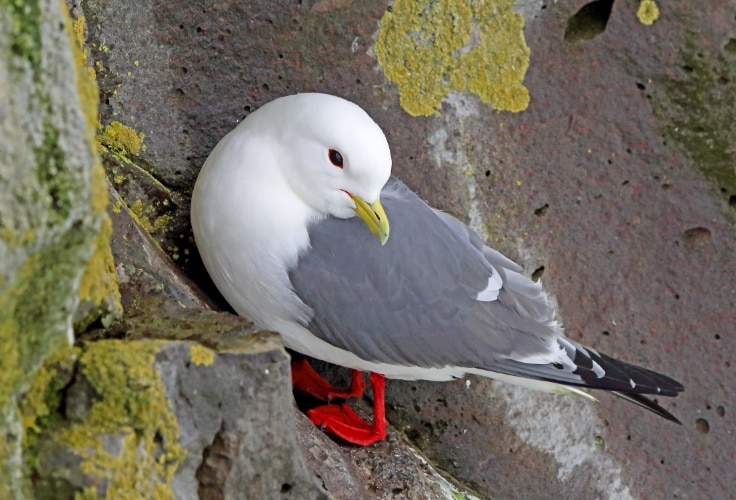
The red-legged kittiwake is one of the most range-restricted gulls in North America, known almost entirely from a handful of colonies in the Bering Sea. Adults measure 35 to 39 centimeters (13.8 to 15.4 inches) in length, with short legs, a compact build, and a distinctive profile shaped by the steep forehead and stubby bill. Their vivid red legs and darker gray back make them stand out from the more numerous black-legged kittiwakes that share their cliffs.
Breeding adults are clean white with a dark gray back, black-tipped outer primaries, scarlet legs, and a short yellow bill. The underwing shows contrasting darker gray, adding to their crisp appearance. Non-breeding adults acquire a dusky smudge around the eye and a thin gray ear patch. Juveniles show more black on the primaries and coverts but lack the bold carpal bar and tail band seen in young black-legged kittiwakes, instead showing a more delicate wing pattern.
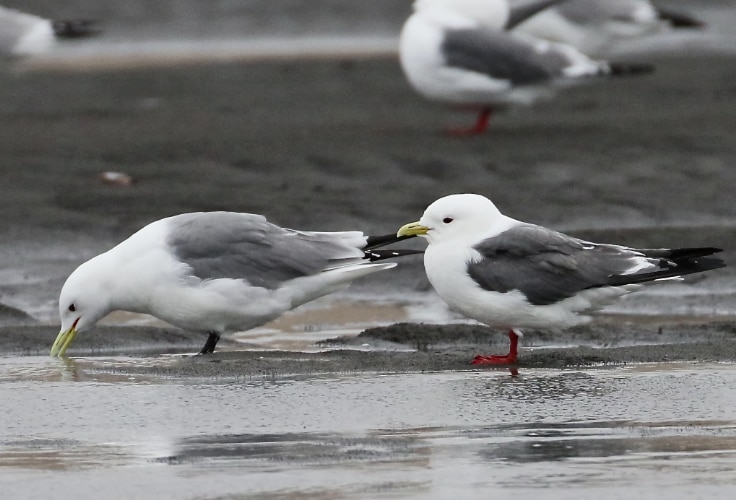
At colonies, these birds are highly vocal, giving sharp, high-pitched “kee-yika” calls and alarm notes distinct from those of their close relatives. They are agile in flight, capable of hovering to reach narrow ledges. On the water they ride buoyantly, dipping and shallow-plunging for prey near the surface. Their diet is centered on small fish and marine invertebrates, often taken in dense flocks and sometimes in feeding frenzies with black-legged kittiwakes. Larger eyes relative to their congeners may aid them in foraging during dim conditions when prey rises toward the surface.
Breeding is confined to just a few islands: St. George, St. Paul, and Buldir in Alaska, with additional colonies on Bogoslof and the Commander Islands of Russia. Colonies are packed onto sheer sea cliffs, with nests on narrow ledges often tucked under overhangs. Birds feed within roughly 150 kilometers (93 miles) of the breeding islands, mostly near the continental shelf edge where ocean fronts concentrate prey. Outside the breeding season, they disperse across the North Pacific, with most records in the Bering Sea, Gulf of Alaska, and occasionally farther south.
This species has experienced marked breeding failures and declines on key islands, particularly St. George, which holds most of the world’s population. Fluctuations appear tied to food shortages linked to oceanographic change. With such a restricted breeding range, the species is highly vulnerable to shifts in prey availability, pollution, and climate-driven alterations of the Bering Sea ecosystem. Protecting foraging habitats and monitoring colony success remain essential to its long-term survival.
Understanding North America’s Gulls
Gulls of North America represent a wide spectrum of forms, from the petite little gull to the powerful great black-backed gull, and from familiar urban flocks to rare Arctic wanderers. Their adaptability has allowed them to thrive in nearly every habitat, whether along remote sea cliffs, prairie marshes, or city shorelines. Yet they remain a challenging group for observers, with many species showing overlapping features and frequent hybridization.
Plumage adds another layer of complexity. Many species display crisp hoods or brighter colors during the breeding season, which in most regions coincides with spring and summer. In the non-breeding months, adults often lose these features and show streaked or smudged heads. Young gulls progress through several years of mottled brown and gray plumages before reaching the neat adult form. Keeping these changes in mind helps make sense of what you see in different seasons.
Whether common or rare, gulls are an integral part of North America’s birdlife, offering endless opportunities for careful observation and discovery. With patience and practice, even this notoriously tricky group reveals its patterns and personalities to those who take the time to watch.

